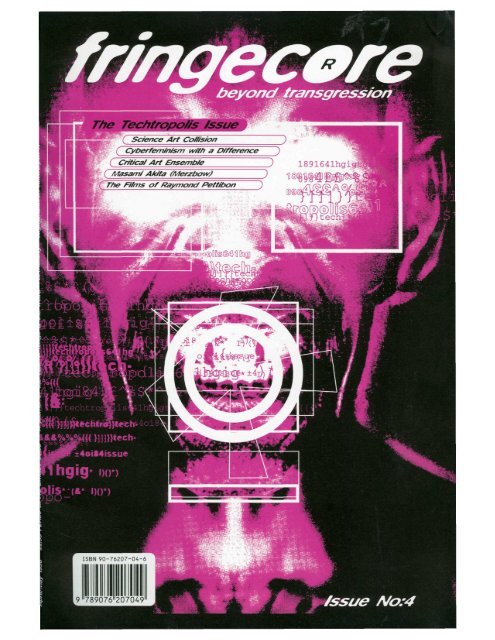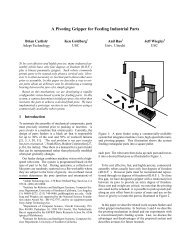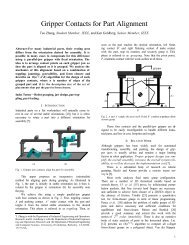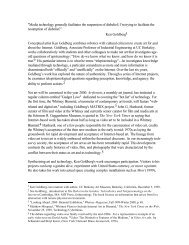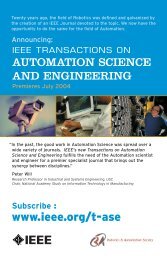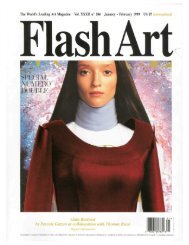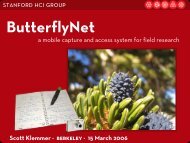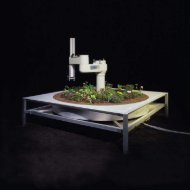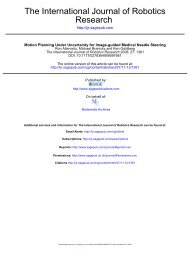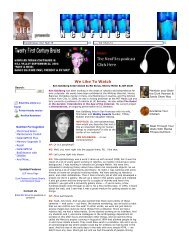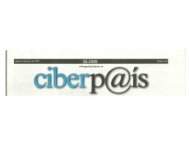The Techtropolis Issue - Ken Goldberg
The Techtropolis Issue - Ken Goldberg
The Techtropolis Issue - Ken Goldberg
You also want an ePaper? Increase the reach of your titles
YUMPU automatically turns print PDFs into web optimized ePapers that Google loves.
<strong>The</strong> <strong>Techtropolis</strong> <strong>Issue</strong><br />
<strong>Issue</strong> 4 April/May 1998<br />
Contents<br />
<strong>Techtropolis</strong><br />
Science Art Collision<br />
Critical Art Ensemble - <strong>The</strong> Flesh Machine<br />
Alife meets Entertainment<br />
My Body, My Software - Dee dissects Orlan<br />
Cyberfeminism with a Difference - Interview with Rosi Braidotti<br />
Art meets Telerobotics: <strong>Ken</strong> <strong>Goldberg</strong> - Out of the Telegarden<br />
into the Shadows<br />
Dreamtime Village - Permaculture and Hypermedia<br />
Spoken Weird<br />
Webster's All New Collegiate NetZine Poetry ManifeStationaryS<br />
Bob Holman<br />
Exercising Devils - Dix<br />
Festival Anti-Image in Seven - Tariq Zayid<br />
We Are All Depraved<br />
Chaos Cookin'<br />
Frank Kozik • Perverting Image<br />
Beyond Ultra Violence/Masami Akita (Merzbow) - <strong>The</strong> Interview<br />
Association of Autonomous Astronauts<br />
Young Farmers Claim Future<br />
Pleasure Trippin'<br />
Human Wave • <strong>The</strong> videos of Raymond Pettibon<br />
Sex Eating<br />
by Jack Sargeant<br />
Regulars<br />
Letters<br />
Bastard Bunny<br />
Scumbag Super 8 • Charles Pinion<br />
Audio Highs • Music Reviews<br />
Badtime Reading • Book Reviews<br />
Netbummer<br />
Upcoming Events<br />
Fleshmeets<br />
Fringecore Feasting at the Festivals: <strong>The</strong> Virtual Recombinants Festival<br />
Fringecore Feasting at the Festivals: Exploding Cinema<br />
<strong>The</strong> Cutting Edge Browser • Maga/Zine Reviews
Telepistemology: t he study of how distance influences belief, truth and perception is a label that <strong>Ken</strong> <strong>Goldberg</strong>, a roboticist<br />
and artist, has applied to his projects, which question how we make sense of our world when our senses are unreliable<br />
guides and what we trust as real complies with no fixed measure of reality.<br />
<strong>Ken</strong>, whom we mentioned in <strong>Issue</strong> 2 of Fringecore in regard to his work with Eric Paulos on the Legal Tender project which<br />
addressed the question of authenticity, by allowing remote users to closely examine a pair of $100 bills, is Associate<br />
Professor in the Industrial Engineering and Operations Research (IEOR) Dept. at the University Of California at Berkeley. His<br />
Teiegarden project which was shown at the SIGGRAPH Interactive Communities Program won him the Kobe Prize at the<br />
Interactive Media Festival in L.A. <strong>Ken</strong> also started the "<strong>The</strong> Art, Technology and Culture Colloquium" at Berkeley.<br />
<strong>Ken</strong> is an artist with a day job as a robotics engineer, which gives him access to robots and computers. Robots play a key<br />
role in his artwork, which approaches technology with an underlying sense of irony. <strong>Ken</strong> is interested in what Gerfried<br />
Stocker calls the "Fleshfactor", what happens when computers interact with the physical world. In particular when this<br />
interaction occurs over a network.<br />
iHis research centres on geometric algorithms for robotics and industrial applications, but he tests it in the realm of art. He|<br />
lis a leader in his field and he established a new standard for human control of robotic motion via the Web. A key concept i<br />
I his art is the idea of feeling directly connected to the activity and knowing that as the viewer you can actually alter the|<br />
I remote site.<br />
<strong>Ken</strong> is best known for his Teiegarden project, which is<br />
a living space tended by a robot arm, controlled by<br />
users via the Internet. It is a real garden of petunias,<br />
peppers, marigolds at the Ars Electrónica Center<br />
Linz, Austria which Net gardeners can work in and nurture.<br />
Anything from seeding to watering, to deciding on<br />
the type of plants.<br />
However, there are a number of other significant projects<br />
which he has developed, including the Mercury<br />
Project (1994), which is an archaeological site based<br />
around a puzzle, drawn from the literary classic, Jules<br />
Verne's "Journey to the Centre of the Earth", and interrelates<br />
the past with the future. <strong>The</strong> Invisible Cantilever<br />
(1996), based on Frank Lloyd Wright's "Fallingwater"<br />
which deals with the question of distance between the<br />
viewer and what is being viewed and its influence on<br />
belief, truth and perception. <strong>The</strong> Shadowserver (1997),<br />
an apparatus housed in a lightbox that contains physical<br />
objects, some of which move on their own accord<br />
within the apparatus. <strong>The</strong> viewer can interact with<br />
these objects via a combination of five buttons and<br />
then cast a shadow, which activates a combination of<br />
lighting devices and returns a digital snapshot of the<br />
resulting shadow.<br />
IAll of these projects are reachable via his home page:<br />
lwww.ieor.berkeley.edu/~goldberg/art/<br />
II spoke to <strong>Ken</strong> about the essence of his art.<br />
Through much of your research you have tried to develop<br />
the perfect robotic hand based on the assumption<br />
that the shape of the human hand is imperfect. What<br />
approach have you taken and how have the results<br />
affected performance?<br />
<strong>Ken</strong>: Actually the human hand works pretty well. Some researchers claim that the best robot hand will be a mechanical version<br />
of the human hand. I disagree. Like most engineers, I'm a minimalist. Perhaps the simplest robot hand is the parallel<br />
jaw gripper: basically a clamp that can open and close. Yet this gripper is incredibly general and is used everyday in factories<br />
around the world. Chopsticks are the best proof that you don't need complex hardware for manipulation.<br />
<strong>The</strong> Mercury Project (1994) was the first telerobotic system on the WWW. It involved a mythical quest - a virtual archaeological<br />
exploration of a mythical place - which if you explore further unfolded a mystery. What are the broader implications<br />
of this project, beyond it being a stimulating, interactive game?<br />
<strong>Ken</strong>: For us, the Mercury Project was both a robot feasibility study and an art installation. We had to decide what to bury in<br />
the sandbox, and wanted all the objects to be related. We drew the objects from Jules Verne's book but only told participants<br />
the objects were from some 19th century novel. <strong>The</strong>ir challenge was to figure out which one. After 7 months and over<br />
2000 pages of log entries, only one person had figured it out; he left a very cryptic message so as not to spoil the secret for<br />
everyone else. Our motive for the secret was to engage participants in an ongoing puzzle.<br />
<strong>The</strong> Teiegarden (1995) has been referred to as "a search for the soul; of gardening". As such it has been essential to the<br />
"gardeners" that they believe it is a real garden which they can access through the Net, not just a set of pre-programmed<br />
computer images. How is this project structured and nurtured and what real life changes have the gardeners been able to<br />
create?<br />
<strong>Ken</strong>: We're hoping the search for the soul of gardening will lead people to log off the net and go outside for some fresh air.<br />
<strong>The</strong> idea of a robot garden is absurd. Some people assume it's a virtual garden, some assume it's real, and the rest suspect<br />
we're pulling their legs. People on the net don't believe there's a real garden, and when my friend Florian Etrody visited the<br />
Ars Electrónica Center the robot was moving around watering a plant and a guy him asked why the robot moved. Florian<br />
explained that a person over the net gave the command and the guy didn't believe it! So the sense of doubt is bi-directional.<br />
This should give us hope. <strong>The</strong> Teiegarden was developed with a group of collaborators including Joey Santorromana, Jeff<br />
Wiegley, Steven Gentner, Rosemary Morris, Carl Sutter, Erich Berger and George Bekey.
One of the key differences between your computer art and the genre in general is the degree of interaction involved, which demands that<br />
the viewer is forced to bring his / her body and senses into play. Is this a key issue for you?<br />
<strong>Ken</strong>: Definitely. I'm trying to understand how the body helps us determine what is real and what isn't. One of the best introductions to this<br />
topic is Benjamin's "Art in the Age of Mechanical Reproduction", a 1936 essay on cinema and photography that is completely relevant to digital<br />
media. He proposes the concept of "aura": that which cannot be reproduced.<br />
How do you explain the difference between telepresence and virtual reality?<br />
<strong>Ken</strong>: VR is simulacral; telepresence is distal. VR is based on illusion while telepresence at least claims to be based on reality. And that brings<br />
up the big question: what's reality?<br />
Your latest project is the Shadowserver which you describe as a WWW-based telerobotic camera obscura aims to answer the question "What<br />
is real?" and addresses the issue of telepistemology from a different perspective. Again it demands a lot of interaction and reintroduces the<br />
concept of contemplation. It has direct links to art history and finally questions the motto of electronic art of making the invisible, visible,<br />
by turning it on its head and making the visible, invisible, into shadows, hiding the object. What are your thoughts on reality and illusion?<br />
<strong>Ken</strong>: When do we get to the easy questions?... Okay, philosophers<br />
TeleroboHcs<br />
into +he Shadows<br />
Hen <strong>Goldberg</strong><br />
have been thinking about epistemology - how do we know? - for 2500<br />
years. In the Republic Plato proposes the parable of the cave, where a<br />
bunch of prisoners spend their life watching shadows on the wall.<br />
That's all they know. Plato uses this analogy to suggest that there is a<br />
higher reality and that we are only capable of seeing a part of it. I<br />
designed the Shadowserver with Bob Farzin to illustrate this idea on<br />
the net.<br />
<strong>The</strong> pictures created trótti thé ühádówsén/ér have been referred to as<br />
"Rayogi aphs", because they resemble the photographs of Man Ray<br />
when h i placed items on photographic sheets and exposed them to<br />
light. Is there a real similarity? Tell me about your links to Marcel<br />
Duchan p.<br />
<strong>Ken</strong>: All contemporary artists owe a debt to Duihamp. His 1916 sculpture,<br />
Ba I of Twine with Hidden Noise, is a ball nf twine sealed at both<br />
ends wi :h something inside that rattles. No one knows what that thing<br />
is. But :o find out means destroying the scul >ture. Duchamp transformed<br />
Plato's concept into the realm of art $nd had a good laugh at<br />
the same time. '•]<br />
<strong>The</strong> qui stion of distance, in particular that t>< tween the viewer and<br />
what is being viewed, is the subject of your Invi. ,'tble Cantilever Project<br />
which h •• 1/i millionth scale vers fon .9f Wright's original "Fallingwater"<br />
and is i nvisible to the naked eye. Fabricated i rom silicon, it demonstrates<br />
the interface between the past and the present and questions<br />
how dis continuities induced by the WWW under/ line what Husserl calls<br />
the innt r and outer horizons of experience. In w iich way does this project<br />
hel, i to study how distance influences the i undamental notions of<br />
how we perceive things?<br />
<strong>Ken</strong>: I I ke that expression: the "naked eye". I i some sense there is<br />
always iistance between us and what we see. But when we insert í<br />
piece of technology! (¡üeh as ayfjglaseoG, in front of the naked eye, ther<br />
we have to ask in what sense are we seeing reality? When Galilee<br />
claimed that he had discovered moons around Jupiter, scientists doubt<br />
ed him, asking: how do you know that your lens is accurate? This ques<br />
tion inspired Dusudrltís Meditations anil in sume sense underlies all o c<br />
-modern sc once. <strong>The</strong> IC, built with Kart Bohr nger, attempts to provoke<br />
this sense of doubt in the viewer by presenting a familiar form just i on the threshold of perception.<br />
Tell me about the new book you are currently working on, <strong>The</strong> Robot in the Ga rden, which f believe is due to be published by MIT Press in<br />
1999? I understand that it gives a more detailed insight into your thoughts on 'he question of "what is real" wht n viewed from a distance.<br />
What new paradigms are you introducing?<br />
<strong>Ken</strong>: <strong>The</strong> book will be co-edited with Jeff Malpas, a philosopher from Australia. Epistemology is one of the oldest branches of philosophy. It<br />
has fallen out of favor since Wittgenstein, since it was seen as focused on scie itific apparatus rather than every< ay life. But since then scientific<br />
instruments in the form of cell phones, pagers, personal organizers, laptc ps, wearable computers etc. have invaded everyday life. Our<br />
hunch is that it may be time to reconsider epistemology. Our goal with the b >ok is to introduce the technology of WWW telerobotics to<br />
philosophers, the subject of epistemology to engineers, and both to the persistent non-specialist. It will include six articles on telerobotic<br />
sites and six essays on the philosophical implications.<br />
Who else are you collaborating with on your new projects and who are the othlpr leading personalities currently involved with the fusion of<br />
art and robots?<br />
I've been lucky to work with some of the best robot artists in the world. You've featured Mark Pauline and Eric Paulos in past issues; I'm<br />
also inspired by the work of Eduardo Kac, Peter Lunenfeld, Lev Manovich, Roger Malina, Susan Collins, John Canny, Judith Donath, <strong>Ken</strong><br />
Feingold, Scott Fisher, Greg Garvey, Emily Hartzell, Perry Hobermann, Rafael Lozano-Hemmer, Steve Mann, Michael Naimark, Michael<br />
Rodemer, Julia Scher, Nina Sobell, Stelarc, Gerfried Stoker, Richard Wallace, and Steve Wilson just to name a few. We've only scratched the<br />
surface, so stay tuned.


